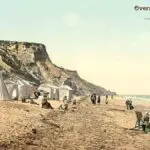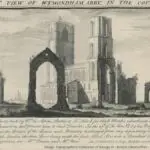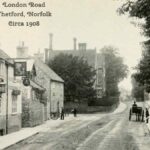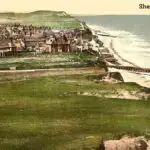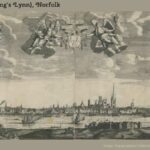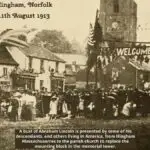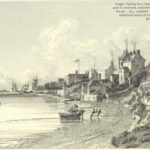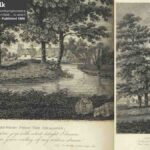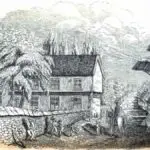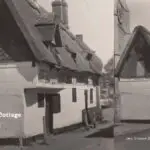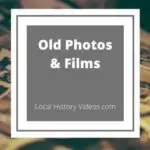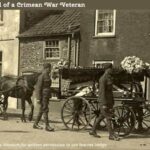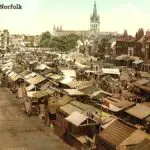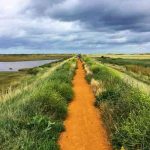Glimpse history through old images of Holt, Norfolk, England.
The old photograph shown above, of a funeral taking place in Holt in 1915, was part of a collection of photographs and postcards compiled by Corporal Harold Vincent Yates, 25th (County of London) (Cyclists) Battalion, The London Regiment.
It is now held in the archives of the National Army Museum in London, who have kindly given me written permission to use a low resolution version of this image. You can order a high resolution copy directly from the museum.
Why did Corporal Yates have this photograph in his collection? Because it shows his fellow soldiers, members of 25th (County of London) (Cyclists) Battalion, The London Regiment, forming the honour guard for the funeral cortege.
The elderly man being buried had fought in the Crimean War, which started as a conflict between Russia and Turkey in October 1853, and was joined by Britain and France in March 1854. Everyone involved suffered terrible losses before the Treaty of Paris brought peace in March 1856.
Unfortunately the Great War, later known as World War I, was already underway when this photograph was taken. The following year, the 25th Battalion was deployed to India to serve on the North West Frontier until the conflict ended in 1918, staying on to participate in the 3rd Afghan War in 1919.
A Video of Holt’s Past
Glimpse history through fascinating old images of Holt, in Norfolk, England, brought together with modern images to create a visual time machine.
Views around Holt, Norfolk through Time – In Motion 3D! The Time Travel Artist (YouTube)
History of the Hundred of Holt
In 1781, a series of books about the areas of Norfolk was published. Volume 7 of the “History and antiquities of the county of Norfolk” included a section on the Hundred of Holt.
This is an extract of the relevant chapter of that book:
THIS hundred was in the crown in the time of King Edward, and on the conquest the Conqueror was lord of it. In the 43d of Henry III it was valued
at 12l. per ann. and in the 14th of Edward I William de Gyfelham is said to hold it of the king.
John de Clavering held it by a grant of Edward I for life,and possessed it in the 9th of Edward II being worth 10l. per ann. and in the 39th of Edward III Robert de Corby had it.
In the reign of James I it was granted to Sir Charles Crnwallis during life,a nd to Charles, eldest son of Sir William Cornwallis, and Thomas, second son of Sir Charles, &c. and the longest liver of them, with all its rights, courts, leets, felons goods, &c. paying 7l. 7s. 4d. per ann.
Holt hundred is bounded on the east by the hundreds of North and South Erpingham,on the left by North Greenhoe and Gallow, on the fouth by the
hundred of Eynsford,and on the north by the British ocean.
The chapter then tells us there are twenty-seven towns in the Hundred of Holt, and shows an analysis of the votes polled at the county elections held at Norwich on May 23, 1768, including for Holt itself.
Next we discover that amongst the area’s seats and principal houses is Edmund Jewell Esq’s property at Holt.
After discussion of some of the properties and parishes in the hundred, the chapter focusses on Holt itself.
Here is an extract:
HOLT, in the Saxon tongue, signifies a wood, from which, it is probable, it derived its name. It was an extensive lordship, and royal demean, in the time of the Confessor, who was lord of it; and there was a sea-port belonging to it, probably Clay, which village was a hamlet to this lordship.
At the survey, Walter Giffard, earl of Bucks, was
lord of it under the protection of Hugh earl of Chester; and all Holt, with its beruites, paid 661. in money per ann.
The earl of Chester had a grant of this great Lordship from the crown soon after the survey, and was held by the Vauxes of the said earl, and after
by the earl of Albemarle, &c.
Holt being a market town, and the principal towns in the hundred, most probably gave name to it.
There isa weekly market held on a Saturday, but when first granted, in the 3d of Edward II in the year 1309, it was on a Tuesday, with a fair yearly on St. Matthew’s eve and day. It is a town pleasantly situated, and in a fine country, that may be justly called the Garden of Norfolk.The scenes around, and the prospects it commands, are more variegated than in any part of Norfolk.The air is sharp, but healthy. There are some good houses in it, but there is a want of water that renders those houses inconvenient, as the inhabitants are obliged to fetch the water at some distance.The quarter sessions of the peace are held here and at Walsingham alternately; and the sessions-house is used as an assembly-room for the monthly assemblies. There is a race ground near the town for running horses, and in the year 1753 there was a meeting; but the
races have since that time been regularly held at Swaffham.
Holt is 124 miles from London, 21 from Norwich, 18 from East Dereham,12 from Cromer, Fakenham and Wells.
The family of de Vallibus, or Vaux, were soon after the conquest enfcoffed of this lordship. Robert de Vaux held it in the 5th of king Stephen, and gave then 531. 6s.8d.livery, for lands of his wife’s inheritance. In the Vauxes it continued till the death of Sir John de Vaux, in the 16th of Edward I. anno 1288, who was a parliamentary baron, &c.and held it of the earl of Albemarle. Margaret de Riparijs countess of Devon, recovered her dower in seven knight’s fees in this town, Cley, &c.held by Baldwin, the late earl, her huſband; and the freeman’s tenures that Giffard held, were after united to the capital manor.
NERFORD’S MANOR.Sir John de Vaux left two daughters and co heirs; Petronilla, the eldeft, married fir William de Nerford, who in her right had a moiety of this town. In the gd of Edward II. the maid Petronilla, then a widow, had a grant of free warren, and a weekly market on Tueſday, and a fair on the eve and day of St. Matthew. Sir John de Nerford poffeffed it in the 2d of Edward III. fettled it on himſelf and fir Thomas his brother, in the 9th of that kingdom whofe death it came to his fon John. Sir John de Nerford, in or about the 38th of Edward III. dying, left Margery his fole daughter and heir, who is faid to have vowed celibacy: the fettled this manor on the lady Alice, probably widow of fir John or fir Thomas de Nerford; this lady Alice married to her fecond hufband fir John de Nevill of Effex, who prefented to this church in 1349, &c. and the in 1375 and 1582. Robert Tyrwhit and Richard Gafcoign prefented to this church in 1422 as lords, and in 1466 Elizabeth dutchefs of Suffolk. In the reign of queen Elizabeth fir Chriftopher Heydon was lord and patron. By the Heydons it was fold to James Hobart, efq, whofe fon Edmund died poffelled of it in 1666: his daughter and heir Hannah brought it by marriage to Dr. William Briggs, phyfician in ordinary to William III whofe fon Henry Briggs, D. D. was rector of this church and chaplain to George II. and died lord and patron in 1748 he married Grace, only daughter of William Briggs, merchant at Liverpool, and left feveral children. William Briggs, M. D. was fon of Augufline Briggs, efq. four times member of parliament for the
city of Norwich, defcended from the Briggs’s of Sall.
Roos’s MANOR.Maud,youngeft daughter and co-heir of fir John de Vaux,married William lord Roos,of Hemlake, lord ofa moiety in her right of this town. William his fon and heir died frized of it in the 17th of Edward III.In this family it continued till Thomas, lord Roos, being attainted in the 1ft year of Edward IV.1461,for his adherence to Henry VI.John Tiftoft, earl of Worcefter, had a grant of it, whofe fifter Philippa the faid Thomas lord Roos had married,and by her had Edmund a fon, and three daughters; Eleanor, Ifabel, and Margaret. Edmund his fon never inherited it, being obliged to live an obfcure and private life, but Eleanor being married to fir Robert Maners, of Etallcaftle in Northumberland, obtained a grant of it, and his fon and heir George, by the faid lady, was lord Roos; Thomas, his fon and heir, was earl of Rutland: Henry,earl of Rutland, his fon, fold it in the ift and ad of Philip and Mary, to Thomas Lodge, efq. afterwards lord mayor of London: it
came then to fir Chriftopher Heydon, and fo to Hobart and Briggs, and was united to the other moiety.
PERERS MANOR.The family of Perers gave name to it,and Roger de Perers held one fee in the 18th of Henry III.
Sir Roger de Perers lived in the reign of Edward II. and his heirs inherited this manor. Of this family was Alice Perers, (that being her true name,and not Pearce as fhe is generally called) the famous miflrefs and concubine of Edward III. who in his 47th year granted her all the jewels which belonged to Philippa, his late queen, with all her goods and chattels, which were in the poffeffion of Euphemia, wife of fir Walter de Hafelacton, and delivered to her by the king’s order: she had been one of queen Philippa’s maids of honour, and married, it is faid, fir Thomas, de Nerford, who died in 1371,and in his will files himfelf of Holt, and defires to be buried, there, 10 let 143
Soon after the death of king Edward. fhe being obnoxious to the duke of Lancafter, and other great lords, was accufed of the flatute of maintenance, and was attainted anno ift of Richard II. in parliament,and her goods forfeited; but in the gd of the faid king, (being then the wife of fir William de Wyndelore) he reftored to them divers manors and lands, anno 1380.
CER The Grefhams afterwards pofleffed it, and fir John Grelham, kut, and alderman of London, bought it of his elder brother, William Grefham, efq. In this capital melluage, or manor-houfe, their father John Grefham, efq. lived, and here the faid fir John and his brother fir Richard (who were lord mayors of London) were born: the deed of fale is dated October 14,1546,in the 37th of Henry VIII.and
the purchate was one hundred and feventy pounds. Sir John converted it into a fchool-houfe, endowing it with this manor, and a grove, called Prior’s Grove, for thirty free fcholars, the mailer to have a falary of gol. per ann, and the ufher twenty nobles; leaving the patronage and government of it to the fifh-mongers company of London. vlimek rid:10
Sir John Grefham (fays the English Traveller) was born at Holt in this county, in 1707, and brought up at the univerfity of Cambridge, from whence he removed to London, and entered into partnerſhip with his brother, fir Richard Grelham, an eminent merchant. He ferved the honourable office of theriff of London, during the year his brother was lord mayor, and founded a free fchool at the place of his nativity, which is under the direction of the company of fifhmongers. He and his brother projected the fcheme of building an exchange in London, which was afterwards compleated by fir John, fon of fir Richard. He died in 1556.
The 1ft year of Richard II. fon of that illuftrious prince, commonly called the Black Prince, from the colour of his armour, fo honoured in the annals of England for his warlike actions, was the year 1378, and the 39th of Henry VIII. that is, the laft year of his reign, was the year 1546, afpace of one hundred and fixty-eight years: here is an hiatus of the poffeffion and different proprietors of one hundred and fixty-nine years, which ferves to demonftrate the uncertainty of proprietors by name or pedigree, in moft of the landed eflates in this county, and in all England, from what is called poffeffion, time immemorial, to a certain family, or families. Wales may be excepted, for the hiftories of that principality being extant before Adam, and the lan guage they are recorded in being only known to the inhabitants of that country, it is impoffible forapoft-diluvian writer to fpeak of their annals with precifion, which may poffibly afcertain the right line of defcenfion from the creation of the world down to Adam, Eve, and paradife, but Englifh records, we are fenfible, are not fo exact,and that they are deficient,this inflance, among a thoufand others, is one. Over the door of the fchool are the arms of the fifhmongers company, and thofe of fir John,with this infcription: Founded by Sir John Gresham, alderman and citizen of London.
A scholarship in Sidney college, Cambridge, belongs to the ſchool, and a fellowfhip there to the faid company. William Bennet, citizen and fifh monger of London, for 6ol.paid to the mafter and fellows had a grant from them, to himſelf, the mafter and wardens of that company, of a fellowfhip, to be enjoyed from time to time by fuch perſon of the faid college who is from this fchool.
HALES’S MANOR.In the 20th of Edward III.William de Hales,Thomas de Grimfby,and William de Norton,held two fees in Holt,Letheringfet and Sharington,of the Nerfords and lord Roos; and in the 25th of that king,fir Stephen de Hales manumitted feveral villains,or flaves,of this manor:he wasaperfon of great eminence in this county,and taken prifoner by Litfter,and the Norfolk rebels,in the reign of Richard II.On his death,it came to his brother Thomas,whofe daughter and heir,Elizabeth,brought it by marriage to William Rockwood,efq.of Warham:his fon William,by his will dated in 1474,orders it to defcend according to his father’s fettlement,and leaving two daughters,Margaret and Agnes, fir Nicholas Appleyard,of Bracon-afh,enjoyed it on his marriage with Agnes:Roger,his fon and heir,died lord in the 20th of Henry VIII.and John his fon had livery of it,who in the 2d and gd of Philip and Mary,conveyed it by fine to fir John Greiham.
After this it came to Thomas Hunt,efq.afoap. boiler in London,who was lord in the 35th of Elizabeth,and Margaret,widow of his fon William Hunt,and daughter of George Briggs,of Wiveton, held it.
Thomas Tomlinfon,efq.citizen and fkinner of London,fold it,with Holt market,to James Hobart,efq,and fo was united to the lordfhip of Holt, Narford,&c.
Hamon de Hempstead lived in the reign of Richard I. and grantedaquit-rent of toll in his market of Holt to the canons of Waltham abbey in Effex. and their tenants.Thomas Fitz-Simon gave two hawks to hold his wood here,and in Cley,in peace, in the 7th of king John,and Simon Fitz-Simon,in the 53d of Henry III.hadagrant of confirmation of the market,and of free warren here.
In the 3d of Edward I. Hugh de Caly was found to hold the market in capite,and paying twenty shillings per ann.and Jolin de Ormefby fued feveral for not paying the toll due at his market here on Saturday;but in the 2d of Henry V. it is faid to have defcended from fir William Caly to his two daughters and co-heirs;Agnes married to fir John Harfyke,of Southacre,and Alice to John Clippefby, efq.and fir Roger Harfyke held it.
Richard Dorward,esq.in right of Joan his wife, daughter of fir Roger Harfyke,owned it in the 33d of Henry VI.and by his daughter and heir,Margaret,it came to fir John Wingfield,of Dunham Magna,and his defcendants.Thomas Wingfield, efq.conveyed it,in the 24th of Henry VIII.to the earl of Rutland,and being united to his manor of Roos,came,as there mentioned,to Dr. Briggs.
The priories of Waborne, Hempton, Castleacre, &c. had temporalities in Holt.
On Saturday the 1st of May, 1708, great part of the town was destroyed by a dreadful fire, so fierce that the butchers could not save (as it is said) the meat on their stalls, being market-day.
The church of Holt is a rectory, dedicated to St. Andrew. Before the fire, it had a nave, north and fouth aile, a square tower, with a spire so high, as to be a sea-mark: the chancel after this was fitted up for the reception of the parishioners.
On the fouth wall of the chancel is a mural monument:
Here lyeth the body of Edmund Hobart, Gent.of this town, son and heir of James Hobart, Esq. by Hannah his wife, descended from an ancient and honourable family of that name in this county, that had in Henry VII and James I’s reign, a learned attorney-general, and an eminent lord chief justice, the great
ornaments of it. He married Bridget, daughter of Woodhall Street, of Oxfordshire, Gent. by whom he had only one daughter, Hannah, sole heiress of his estate and manors of this town, since married to Dr. William Briggs in London, physician to his Majesty’s hospitals, by whose appointment this monument was here placed. He died February 13. A. D. 1666, in the 52d year of his age, after he had escaped the malice of the Usurper, who for his loyalty to Charles I. fought after his life, and forced him from his paternal feat to live in obscurity, but his loyalty kept him stedfast thro the forms of that rebellion, and here at last he found rest, and expects a blessed immortality.
On the summit the arms of Hobart, fable, an estoil, or, between two flaunches, ermine.
Against the north wall a mural monument;
Subjacent reliquia, fpe beata refurrectionis, Elizabethe, filiae Joh. Ellis de Wymondham, vere, chara nec minus pia conjugis Joh. Newdigate, medici de Holt, quinquies matris liberis, fuperfunt Edmundus, Maria, et Joh. que obt. diefeptimo Febr. 1710, quarto et quadragefimo ætatis A.
On another: M. S.-Samuel Butler, nup.de Holt, in agro Norf pharmacopola, vir pius et ingenij tam alienis quam fuis acutus, tot idoncis diverfi nominis officijs; quot vitam fuam plurimum fpeélabilem, et morten multuan effecere de fiendam, bene de cognatis, amicis et fodalibus, meritus. Deo nimam homini famam,terra corpus,in fpem resurrectionis reliquit A. D. 1697, Junii 19, at.74.
In the church were the arms of the earl Warren-Vaux-Lord Roos,
There is a manor belonging to the rectory, presented by Thomas Bromfield, M.D.
Briggs bears quarterly, gules, three bars gemelle, or, and a canton, fable, in the 1ft and 4th quarter, by the name of Briggs, and in the second and third Hobart.
Henry Briggs was buried in the chancel, under a black marble:
Here lieth interred the body of Henry Briggs, D. D. who was twenty-fix years rector of this parish,and chaplain in ordinary to his Majesty George II. He was diligent in his ministerial office, exemplary in piety, a friend to the distressed, and bountiful to the poor. His whole life bespoke him a true Christian, ever chearful and preparing for a happy eternity. Reader,according to thy station, go thou and do likewife. He died May 31, 1741, aged 61,l eaving behind him to lament his loss, his widow, Grace, and four children, William, Hobart, John, and Elizabeth, and one grandchild, Amelia, daughter of his eldeft son,who died at Bengal in May 1747.
This town gave name to the deanry of Holt.
The Rev. Joshua Smith was presented to this rectory by Elizabeth Briggs, his wife, in 1750.
More about Norfolk
- Old Images of Norfolk, England
- Old Images of Wymondham, Norfolk
- Old Images of Thetford, Norfolk
- Old Images of Sheringham, Norfolk
- Old Images of King’s Lynn, Norfolk
- Old Images of Hunstanton, Norfolk
- Old Images of Hingham, Norfolk
- Old Images of Gorleston-on-Sea, Norfolk
- Old Images of Fakenham, Norfolk
- Old Images of Diss, Norfolk
- Old Images of Dereham, Norfolk
- Old Images of Overstrand, Norfolk
- Old Images of Attleborough, Norfolk
- Old Images of Holt in Norfolk
- Old Images of Cromer, Norfolk
- Old Images of Norwich, Norfolk
- Old Images of Great Yarmouth, Norfolk
- Norfolk: Local History Resources


